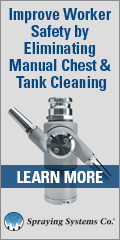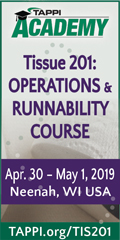
| Archive/Subscribe | TAPPI.org | Advertise | TAPPI Press Catalog | April 2017 |
Lucart Recycles Used Beverage Cartons into Sanitary Paper
Komunala Novo mesto was the first municipal services company in Slovenia to take part in a pilot project to close the materials cycle for waste milk, juice and other beverage cartons (used beverage cartons or UBCs). Through a series of specially designed activities, they were encouraging schools and households to collect UBCs separately and to pass as many of them on for recycling as possible. This was part of Novo Mesto’s efforts to gradually establish its own closed materials loop for waste BCs, thereby securing enough raw materials to produce its own supply of sanitary paper over the long term.
Komunala Novo mesto provides municipal services for eight municipalities covering a total population of 65,000. This population disposes enough waste milk and juice UBCs per year in yellow containers or bags to provide just enough resource of cellulose for the production of annual quantity of sanitary paper used by local public institutions – municipal government offices, schools, nursery schools, health centers, libraries and the like. Around 45 hectares of woodland would have to be felled to make this quantity of sanitary paper; but if all UBCs in the area covered by Komunala Novo mesto were recycled into sanitary paper, this would meet the entirety of local needs and, moreover, save around 1,100 trees and provide total independency from primary resources. In a desire to lead the way in establishing this method of conserving the environment, Komunala Novo mesto has decided to take part in the pilot project.
The key partners in these efforts to close the materials cycle for UBCs in Novo mesto: Komunala Novo mesto, Slovenia; Dinos DROE Unirec waste packaging management company, Slovenia; Lucart, Italy; and EKO Iniciativa (community of businesses and institutions) set up and coordinated by Valtex, Slovenia.
Once the end users have emptied, cleaned and folded the waste packaging, and placed it in the designated yellow container, Komunala Novo mesto takes it to the collection center. There it is received by Dinos DROE Unirec and sent for further processing to the Lucart. Lucart then separates the cellulose and uses it as a secondary raw material for the production of sanitary paper.
Komunala Novo mesto began by choosing four primary schools to take part in the project. As part of a class competition, pupils received special bags to use at home to collect and separate waste UBCs. At collection days, four per year, the packaging collected was brought to school, where Komunala staff examined it and awarded stickers. The class that collected the most stickers by the end of the year was the class that most diligently, consistently, and correctly separated its waste packaging. It was declared the winner and received a prize.
The Fiberpack® logo (www.fiberpack.com) identifies the fibrous raw material obtained through Lucart exclusive treatment process of beverage cartons, which is used to produce Lucart Professional EcoNatural and Grazie Natural branded products.
The production process uses an innovative technology, which, by physical-mechanical action, separates the cellulose fibers found in beverage cartons from polyethylene and aluminium without using substances that are harmful to man or the environment.
The fibers are therefore used to obtain tissue products, whereas aluminium and polyethylene are recovered in other industries to produce items for a number of end uses.
Fiberpack® products feature a light Havana brown colour because the cellulose fibres are not bleached. The products feature excellent resistance, absorbency and softness and are 100% ecological, EU Ecolabel and FSC® Recycled certified.
Closing materials cycles, or what is known as the circular economy, is one of the mainstays of European Union policy currently and will be in the coming years. Establishing a circular economy means addressing the entire lifecycle of a product and its component materials, then defining the proportion of these materials that can be reused – and the form of reuse.
The foundations have now been laid with this project in Novo mesto which aims to close the materials cycle for UBCs. It all started mid 2016 when the first quantities of UBCs were designated for being recycled into sanitary paper. By early 2017 in the city of Novo mesto 35% of the demand for sanitary paper products are now covering citizens by themselves, with their own contribution of UBCs. It is hoped that the Municipal Material Cycle of Novo mesto can achieve its full effect by 2018, covering as much as 80% of local demand for sanitary paper products.
The general public has also had the chance to take part, taking bags containing UBCs to the Komunala Novo mesto collection center and receiving a small gift from the EKO Iniciativa community in return: paper tissues made from recycled cellulose. Both activities were used to communicate the project with general public.
|



